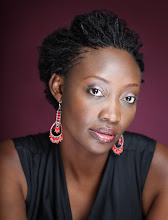Photo credits: Ade Omoloja
Stumped mannequins suspended from the ceiling on strings, clean minimalist interiors, traditional craftsmanship baptized in a blend of science and modern British design. It is called Pokit, pronounced poket or “apo, we started out making bags,” says founder Bayode Oduwole of the line which he co owns with his wife Claire Oduwole. Bayode started out as a pharmaceutical chemist but had his own ideas of good design. Frustrated with hollow fashion trends, he decided to put his time where his heart was and began making big pockets for the small but knowing clientele. Wallpaper featured Pokit in their June 2008 edition titled The Secret Elite and Mrs. Oduwole agrees that their clients often like Pokit to be “their little secret.” But Bayode has a contrary opinion, “if there is a word I could delete from the English dictionary it’s the word exclusive” he says with finality. As with Pokit’s patrons, the line has since expanded to men and women’s casual and formal wear with a specialty in suits. The label has a wide range of customers from “the 50-year-old Cambridge professor to the 16-year-old fashion kid” says Bayode. The average Pokit suit costs £700 (N161, 000) and takes two weeks to make against the average Savile row suit, which costs £3,000 (N690, 000.00) and takes four months to make. What sets Pokit apart from the pack is “modesty and honesty and this is coherent through our design and the lay out of our store. We make sure that the best quality goes into material, craftsmanship and service. With our suits, we work with silhouettes 50% of the time and the other 50% of the time we focus on how it wears. We have a modern take on making our suits. So it doesn’t matter that a person spends a week hemming a jacket because a machine can do that far quicker today and far better than it could two hundred years ago when the sewing machine was first made.”
Above: Claire and Bayode Oduwole
Photo credits: Ade Omoloja
Running features in Pokit’s designs are domes, round edges, earth, and hexagons inspired by Richard Buckminster Fuller- an American architect who was famous in the 1950s up until his death for his geodesic domes. Pulling inspiration from America, England and Japan, Oduwole maintains that he is a Nigerian citizen of the world and the Pokit brand is a global brand. His clients are also global which is why he vehemently denounces the ethnic tag. In a passionate crescendo he argues “A designer is a designer, if he is good he is good. Too often I get people coming to me saying they got a scam fax from someone in Nigeria, and what I ask is, did you send the money? The one who sends the fax and the one who sends the money are both complicit in the scam. The only thing is the white man is thinking ‘those spear slinging Africans can’t possibly be clever enough to swindle me’. For too long the West has used the Nigerian tag negatively and I refuse to be the ethnic on the block.” When asked if there are Nigerian influences in his designs he says in Yoruba“When I am creating, I think to myself, I don’t want to get verbal abuse in Yoruba because it stings so I know I better do this right”. Needless to say Pokit’s women’s summer collection featured a row of tweed skirts broken with damask bands. “If you look at it and you recognize damask as Nigerian then fine, but otherwise, just enjoy it as a good design.”
Pokit is located on 53 Lamb Conduit Street, London UK
http://www.pokit.co.uk/
Pokit is located on 53 Lamb Conduit Street, London UK
http://www.pokit.co.uk/
EO
This 2020visionng article is powered by Interswitch.







